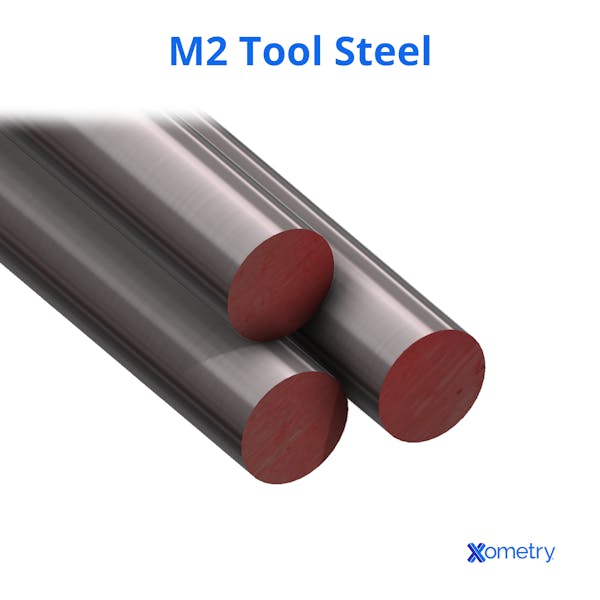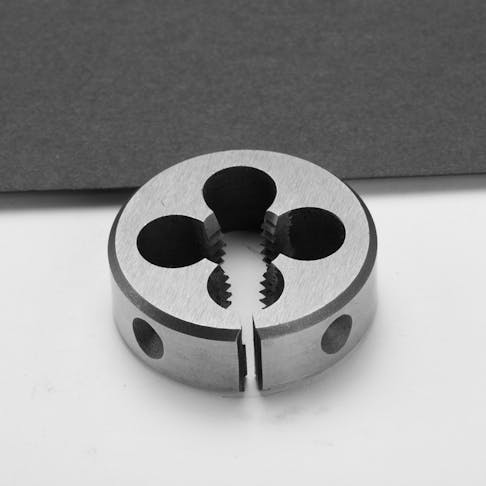M2 tool steel is one of the high-speed tool steels. In addition to its relatively high carbon content, M2 contains tungsten and molybdenum as its key alloying elements. M2 tool steel has excellent abrasion resistance, hardness, and toughness, making it ideal for metal-cutting tools.
This article will describe what this material is, how it's made, its chemical composition, and key properties.
What Is M2 Tool Steel?
M2 tool steel is a high-carbon, high-molybdenum, and high-tungsten steel alloy, one of the most widely used grades of high-speed steel (HSS). In M-series tool steels, the ‘M’ designates molybdenum-based high-speed steels, and the number indicates the specific grade within the series. It is often used for cutting tooling due to its high hardness, high toughness, heat treatability, and good abrasion resistance. M2 is typically used in tooling applications such as drills, end mills, taps, and reamers, where high hardness and wear resistance are needed.
How Is M2 Tool Steel Made?
M2 high-speed tool steel can be made using a number of processing techniques. The most common technique is by melting metal in an electric arc furnace along with the required alloying elements. Impurities are removed, after which the molten metal is cast into ingots. These ingots are then forged into the required shapes for further processing. After forming, the material is annealed and then hot-rolled or forged into standard stock shapes such as bars, rods, and flats.
How Does M2 Tool Steel Differ From Stainless Steel?
In general, steels are classified as “stainless” when their chromium content exceeds a certain amount, typically 10.5%. M2 tool steel’s chromium content is lower than that required for stainless classification, so it offers relatively poor corrosion resistance and is not suited for similar applications. M2 tool steel has superior abrasion resistance and retains hardness at elevated temperatures, unlike stainless steels, which lose hardness more quickly when heated.
To learn more, see our guide on Stainless Steel Uses.
How Much Does M2 Tool Steel Cost?
Tool steel is sold in standard stock shapes like solid square bars or rods, specifically for the purpose of creating cutting tools. For example, a 1” x 1” x 7” long square shank may cost over $150, while a 5/32” x 3 ⅛” long round shank may cost only a few dollars.
Is M2 Tool Steel a High-Alloy Steel?
Yes. High-alloy steel is defined as steel with alloying elements totaling at least 5% by weight. M2 tool steel qualifies since it contains significant amounts of molybdenum, tungsten, vanadium, and chromium, which together far exceed 5%.
To learn more, see our guide on What is Alloy Steel.

What Are the Uses of M2 Tool Steel?
M2 tool steel is primarily used to make cutting tools for subtractive manufacturing processes such as drills, end mills, taps, saw blades, and reamers. M2 tool steel is also used to produce cutting tools such as metal cutting saws. Its excellent abrasion resistance also makes it useful for specialized injection molding tooling, where molds are exposed to high-pressure plastics that demand materials with high wear resistance.
Is M2 Tool Steel Good for Knives?
Yes, M2 tool steel is a good option for fabricating knives. It can maintain a sharp edge due to its excellent hardness and abrasion resistance. M2 tool steel has limited machinability and is usually shaped by grinding or with specialized tooling. When machining, specialized tooling such as CBN (Cubic Boron Nitride) is required because of M2’s high hardness. Tool steels are not as corrosion-resistant as stainless steels and are not suited for applications where the knife needs to be cleaned in a dishwasher, for example, which can be very corrosive environments.
What Is the Chemical Composition of M2 Tool Steel?
The key elements in M2 tool steel are molybdenum at (4.5–5.5%), tungsten (5.5–6.75%), vanadium (1.75–2.20%), chromium (3.75–4.50%), and carbon (0.78–0.88%). The molybdenum, vanadium, chrome, and tungsten give tool steels their excellent hardness and wear resistance due to the formation of carbides, while also improving their high-temperature wear resistance. The relatively high carbon content aids in the formation of carbides and increases the overall hardness of the matrix. Table 1 below indicates the typical chemical composition of M2 tool steel:
What Is the Carbon Content of M2 Tool Steel?
M2 tool steel has a carbon content of between 0.78 and 0.88% by weight. This is in comparison to a carbon content of about 0.17–0.23% for AISI 1020 mild steel. High-carbon steels tend to be harder and more brittle, while lower-carbon steels are generally tougher and more ductile.
What Are the Properties of M2 Tool Steel?
Table 2 below lists some key properties of M2 tool steel:
What Is the Machinability Rating of M2 Tool Steel?
M2 tool steel has a machinability rating of about 35-40% compared to SAE 1112 steel at 100%, C360 brass at 170%, and Inconel® 625 at around 17%. Machining M2 tool steel is difficult and generally requires specialized tooling such as CBN or carbide due to its high hardness. It is recommended that CBN (Cubic Boron Nitride) tooling be used due to its high hardness.
What Are the Characteristics of M2 Tool Steel?
Listed below are some key characteristics of M2 tool steel:
- M2 tool steel offers excellent wear and erosion resistance.
- It has good toughness, making it resistant to cracking and chipping.
- It retains hardness and strength at elevated temperatures.
What Are the Thermal Properties of M2 Tool Steel?
Tables 3 and 4 below list some common thermal properties of M2 tool steel:
What Are the Advantages of Using M2 Tool Steel?
Listed below are some key advantages of M2 tool steel:
- M2 tool steel can reach 60–65 HRC and retains hardness at elevated temperatures, giving it excellent hot (red) hardness. This hardness is what makes it ideal for use as a cutting tool material, as it can maintain an edge under high-stress, high-temperature service conditions.
- It has excellent wear resistance. This translates to longer tool life when used for manufacturing tooling.
- It has good toughness for a high-speed steel, meaning it is less prone to chipping or cracking compared to other very hard tool steels.
What Are the Disadvantages of Using M2 Tool Steel?
Listed below are some key disadvantages of M2 tool steel:
- It has a low machinability rating (about 35–40% of free-cutting steel), so it is usually ground or cut with specialized tooling such as carbide or CBN.
- While M2 tool steel contains chromium and molybdenum, it is in relatively small amounts when compared to stainless steel. For that reason, it has comparatively poor corrosion resistance.
- M2 tool steel requires multiple heat-treatment steps, such as annealing, hardening, and tempering, to achieve its optimal properties, which adds processing complexity and cost.
Frequently Asked Questions About M2 Steel
Does M2 Tool Steel Rust?
Yes. M2 tool steel is not designed for corrosion resistance and will rust if not protected.
Can M2 Tool Steel Be Welded?
Yes, M2 tool steel can be welded, but it is difficult and not generally recommended. If welding is required, it must be preheated (typically 260–540 ºC depending on prior heat treatment) and post-weld heat treatment is necessary to restore hardness and toughness.
Is M2 Tool Steel Corrosion Resistant?
No. M2 tool steel has only moderate corrosion resistance and does not match the performance of stainless steels.
Can M2 Tool Steel Be Tempered?
Yes, M2 tool steel can be tempered. It is typically tempered between 540 ºC and 595 ºC, which results in a final hardness of between 60–65 HRC.
Is M2 Tool Steel Better Than D2 Tool Steel?
No, M2 tool steel is not necessarily better than D2 tool steel. D2 has higher wear resistance and better corrosion resistance due to its chromium content, while M2 has greater toughness and hot hardness. The better choice depends on the application.
What Is the Difference Between M2 Tool Steel and T1 Tool Steel?
Both M2 and T1 are classified as high-speed tool steels. The main difference between M2 and T1 steels is that M2 contains both molybdenum (about 5%) and moderate tungsten (about 6%), while T1 contains no molybdenum and very high tungsten (around 18%). T1 is used for drills, taps, and other cutting tools, though M2 has largely replaced it due to M2’s greater toughness and lower production cost.
Summary
This article presented M2 tool steel, explained it, and discussed its composition and various applications. To learn more about M2 tool steel, contact a Xometry representative.
Xometry provides a wide range of manufacturing capabilities and other value-added services for all of your prototyping and production needs. Visit our website to learn more or to request a free, no-obligation quote.
Disclaimer
The content appearing on this webpage is for informational purposes only. Xometry makes no representation or warranty of any kind, be it expressed or implied, as to the accuracy, completeness, or validity of the information. Any performance parameters, geometric tolerances, specific design features, quality and types of materials, or processes should not be inferred to represent what will be delivered by third-party suppliers or manufacturers through Xometry’s network. Buyers seeking quotes for parts are responsible for defining the specific requirements for those parts. Please refer to our terms and conditions for more information.


